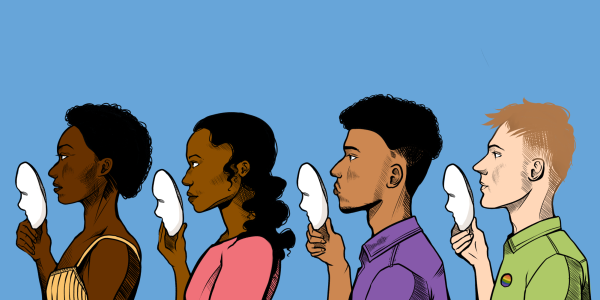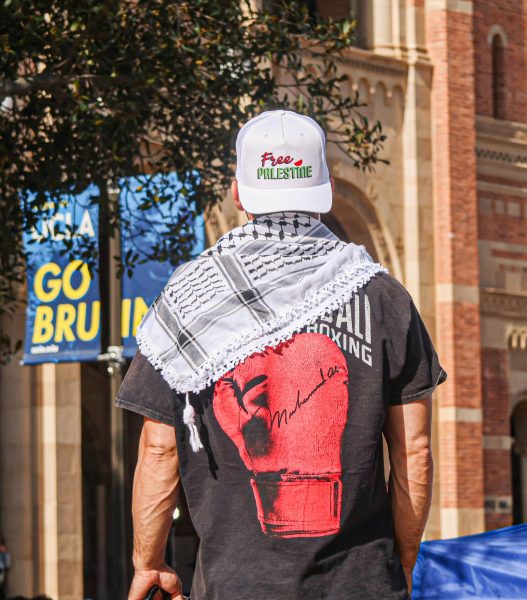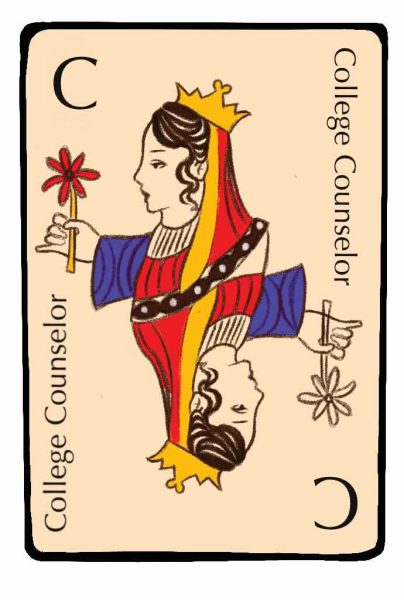Appreciation or Appropriation
Students engage in discussions regarding the sensitive boundary lines between cultural appreciation and appropriation on campus.

Photo Illustrations by Alexa Druyanoff of representations of culture groups on campus.
March 24, 2022
As Savannah Shaub ’23, who identifies as white, examined this year’s new clubs list, she said she noticed few spaces for students to discuss Chinese culture at the Upper School. Seeing this as an opportunity, Shaub said she created the Chinese Pop Culture Club to discuss Chinese fashion, celebrities and food and to allow students, regardless of their fluency in the Chinese language, to share insights on these topics.
Shaub, who began taking Mandarin in her freshman year at the Middle School, co-founded the club with Neleh Kay ’23, who identifies as Chinese American. Discussion topics in meetings have ranged from the recent Winter Olympics to Chinese celebrities.
Shaub said her appreciation for Chinese culture and language has grown since enrolling in Chinese classes at the school, and she said she hopes to share her interest with others through her club.
“[Creating the club] was an amazing opportunity to expose [people] to [this] fascinating and beautiful language,” Shaub said. “I feel a connection to it as I keep learning more about [it], and I wanted to share some of that with other people.”
Shaub said because her club focuses on pop culture, they spend less time on the more sensitive aspects like discrimination, bigotry and oppression that affinity groups such as Asian Students in Action (ASiA) and Black Leadership Awareness and Culture Club (BLACC) discuss in their meetings.
“A lot of our members are not Chinese or Asian, so it’s not our place to discuss some of the more vulnerable topics or ways in which they might feel,” Shaub said. “I think that there’s a fine line between talking about current news and talking about oppression, for example. We [have] made sure there is a big difference between pop culture and true culture.”
Shaub said she does not intend to appropriate aspects of Chinese culture in creating and running her club.
“It’s not [the club’s] place to take [Chinese] culture as our own, but instead to shine light on aspects of [it] and appreciate the pop culture facets of it,” Shaub said. “We just wanted to make a separate, different, super uplifting [and] fun community that has no affiliation. We [are not] trying to take away from ASiA or culturally appropriate by any means. That would be wildly inappropriate.”
ASiA Co-Leader Anabelle Kang ’22 said affinity groups and cultural clubs play different roles as outlets for students.
“With an affinity group, one part of it is that there comes a much bigger responsibility to uphold values of diversity, equity and inclusion,” Kang said. “To me, an affinity group mainly serves as a processing space to understand and recognize your own identity and culture. A club, while it can function as what my definition of an affinity group is, is mostly activity-based.”
Kang said she was confused about Shaub’s role in Chinese Pop Culture Club, as she said she does not think people should lead spaces promoting cultures that are not their own.
“I totally get wanting to learn about another culture,” Kang said. “It’s super important to engage with other cultures and gain that cultural perspective. But when you create a club, it’s something that you know a lot about and you’re passionate about and you want to share it with others. If you’re white, it’s not your culture to share.”
Kang said ASiA is open to all students and provides a safe space for students of all identities to be included in discussions and celebrations.
“A big difference between [the Chinese Pop Culture Club] and ASiA is that we care a lot about creating a community where students can get vulnerable or just celebrate traditions with us and feel included in the school,” Kang said.
Kang said ASiA also discusses aspects of Asian pop culture and hosts activities to celebrate and inform others about it.
Although Shaub said she enjoys discussing different aspects of Chinese pop culture, according to the official ASiA member roster, she is not a member of the group.
Brandon Aghnatios ’23 said he enjoys attending ASiA meetings because he believes it is beneficial to learn about his peers’ experiences as Asian students.
“[ASiA is] a wholesome community,” Aghnatios said. “I’m not Asian, so there are moments when I don’t have much to say, but I like to be there because a lot of my friends are Asian. I like to know what they might be going through [and] how they’re feeling.”
Aghnatios said students at the school value the perspectives they gain from their peers.
“I see a lot more appreciation than I do appropriation [at the school],” Aghnatios said. “This is a very respectful and closely knit community that is cognizant of each other’s boundaries and where to draw the line. A lot of the appreciation happens when one recognizes different facets of a culture that is not their own and then tries to gain an understanding and a respect for it, which I think is quite beautiful.”
Patrick Yeh ’23 said he notices cultural appreciation on campus when students come to meetings and events to support their peers of other cultures.
“Appreciation doesn’t necessarily have to mean going out of your way and trying to display that you’re an ally but just being there and being present and being able to listen,” Yeh said. “It’s also about having that sense of community, no matter what race you are.”
Jayden Huang ’23 said affinity and culture groups at the school are open to all, but he said he is aware that it can be challenging to attend a group one is not a part of.
“I understand some people may feel uncomfortable going to an affinity group if they are not the race or ethnicity of said group, but ASiA and the other affinity groups are constantly welcome to everyone,” Huang said. “In fact, oftentimes people not of the race or ethnicity are encouraged to attend the meetings, as it is important that [Black, Indigenous and other people of color’s ] voices are spotlighted.”
Latin American Hispanic Student Organization (LAHSO) Leader CC Mesa ’22 said students can support groups that they do not identify with by coming to cultural events and participating in activities organized by affinity groups.
“One way that [cultural appreciation] manifests on campus is when certain clubs have events like ASiA’s Lunar New Year [festival] or LAHSO’s Hispanic Heritage Month table,” Mesa said. “We see people that are not of those particular identities still playing the games with us or getting food and telling us that they enjoy the games and the food.”
Mesa said she appreciates that many of her peers who attend LAHSO meetings are not of Hispanic heritage.
“It’s important to have people who are not of that certain affinity in the room because it’s important not only for them to get educated on our issues, but to educate us on the outsider perspective,” Mesa said. “I find that it’s been very helpful at times [to have people of other backgrounds in meetings]. I have friends who take Spanish and can speak on how Latin America is taught in Spanish class. They definitely can contribute an outsider’s perspective on issues, which is very important because you need a bunch of different perspectives.”
Mesa said if a person does not belong to a particular culture, they should not start a cultural group for it.
“I don’t think it’s your place to start a group as being a safe space for people on campus, a space that’s not necessarily your own,” Mesa said. “Even though I have been to ASiA meetings and I’ve been to BLACC meetings, and I’m not Asian or Black, I don’t think it’s okay for people to start that group [if they don’t identify with it]. Why do you feel the need to have that space on campus if it’s not an issue that you yourself are dealing with?”
Mesa said she sees appreciation as learning about and celebrating another culture while acknowledging the history of that culture.
“Cultural appreciation and allyship is where you feel that you can enjoy aspects of a culture but not necessarily claim them as your own or profit off of them,” Mesa said. “Cultural appreciation is recognizing [that a culture] is not your own but still enjoying it in a method that is sanctioned by people in that culture.”
BLACC member Idalis McZeal ’23 said it is difficult to draw the line between cultural appropriation and appreciation, but she said she ultimately sees it as a matter of understanding.
“Cultural appreciation is when you are able to understand where one’s culture came from, take its context and understand how it influences the people who the culture is a part of,” McZeal said. “Appropriation is when you use these pieces of culture for your own benefit without truly understanding the effects that it [has] on these cultures.”
McZeal said the appropriation of Black culture is particularly harmful because people adopt the culture as their own, despite understanding the history behind it.
“Specifically within the Black community, we’ll do something and then it’s viewed as urban or ghetto,” McZeal said. “But then it’s taken and used as high fashion. You shouldn’t be allowed to take something that people have been oppressed for or looked down upon for.”
McZeal said the role of an affinity group is to create safe spaces, while culture groups should focus on spreading awareness of a culture.
“An affinity group is there to provide people who are within a culture a space to express their difficulties or the problems that they face in their day-to-day life, especially in a predominantly white institution,” McZeal said. “A culture group’s point is to be able to inform the larger community about that culture and about the things that [the members of that culture] face.”








































